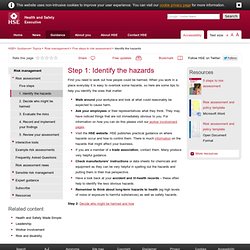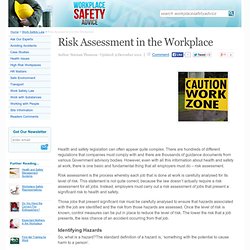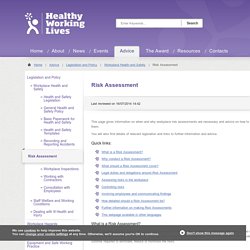

Norman Caudwell
Barnsley College
Hazard and Risk. What is a hazard?

The meaning of the word hazard can be confusing. Often dictionaries do not give specific definitions or combine it with the term "risk". For example, one dictionary defines hazard as "a danger or risk" which helps explain why many people use the terms interchangeably. There are many definitions for hazard but the more common definition when talking about workplace health and safety is: A hazard is any source of potential damage, harm or adverse health effects on something or someone under certain conditions at work. Basically, a hazard can cause harm or adverse effects (to individuals as health effects or to organizations as property or equipment losses).
Sometimes a hazard is referred to as being the actual harm or the health effect it caused rather than the hazard. What are examples of a hazard? Workplace hazards can come from a wide range of sources. As shown in Table 1, workplace hazards also include practices or conditions that release uncontrolled energy like: Health and Safety Assignment Two- Controling Hazards In The Workplace. SCENARIO. ASSIGNMENT TWO SCENARIO. Risk management: Step 1: Identify the hazards. First you need to work out how people could be harmed.

When you work in a place everyday it is easy to overlook some hazards, so here are some tips to help you identify the ones that matter: Walk around your workplace and look at what could reasonably be expected to cause harm. Ask your employees or their representatives what they think. They may have noticed things that are not immediately obvious to you.
For information on how you can do this please visit our worker involvement pages[1]. Step 2: Decide who might be harmed and how[3] worker involvement who might be harmed and. Search HSE website. Risk Assessment in the Workplace. Author: Norman Thomson - Updated: 9 December 2012| Comment Health and safety legislation can often appear quite complex.

There are hundreds of different regulations that companies must comply with and there are thousands of guidance documents from various Government advisory bodies. However, even with all this information about health and safety at work, there is one basic and fundamental thing that all employers must do – risk assessment. Risk assessment is the process whereby each job that is done at work is carefully analysed for its level of risk. Those jobs that present significant risk must be carefully analysed to ensure that hazards associated with the job are identified and the risk from those hazards are assessed. Identifying Hazards So, what is a hazard? There are many hazards around, which may cause harm to a person.
Risk Assessment The definition of risk is, ‘the likelihood and consequence of a hazard being realised’. Control Measures. Advice & risk assessment template forms. This page gives information on when and why workplace risk assessments are necessary and advice on how to conduct them.

You will also find details of relevant legislation and links to further information and advice. Quick links: What is a Risk Assessment? A Risk Assessment is a systematic method of looking at work activities, considering what could go wrong, and deciding on suitable control measures to prevent loss, damage or injury in the workplace. The Assessment should include the controls required to eliminate, reduce or minimise the risks. back to top.
Example COSHH risk assessment - Engineer - COSHH. How do I carry out a risk assessment? There is no set way of undertaking a risk assessment but the simplest and most straightforward way is to consider following the five steps in our leaflet: Five steps to risk assessment Identify the hazards Decide who might be harmed and how Evaluate the risks and decide on precaution Record your findings and implement them Review your assessment and update if necessary Our publication Five steps to risk assessment [2] describes each of these steps in simple terms.

It will help you focus on the risks that really matter in your workplace. We also have a number of example risk assessments[3] which show you what a completed risk assessment may look like for a range of different business types. . [4] which you can fill in to complete your risk assessment requirements. If you work in a low risk office based environment you can complete your risk assessment quickly and easily by using HSE’s new web-based tool[5]. Five steps to risk assessment INDG163.